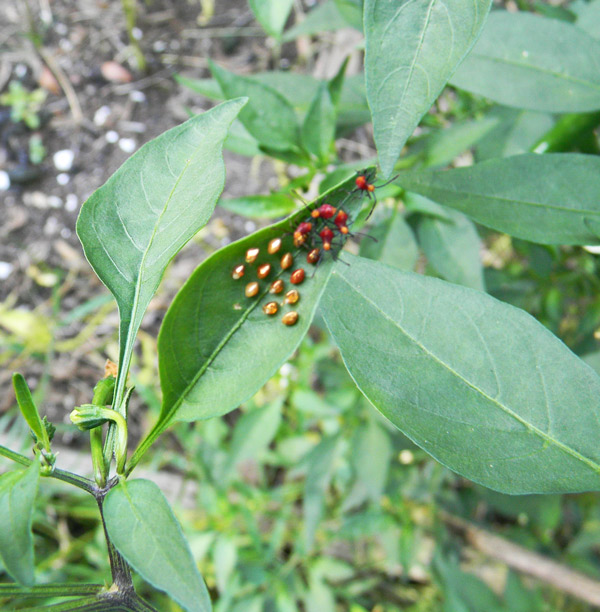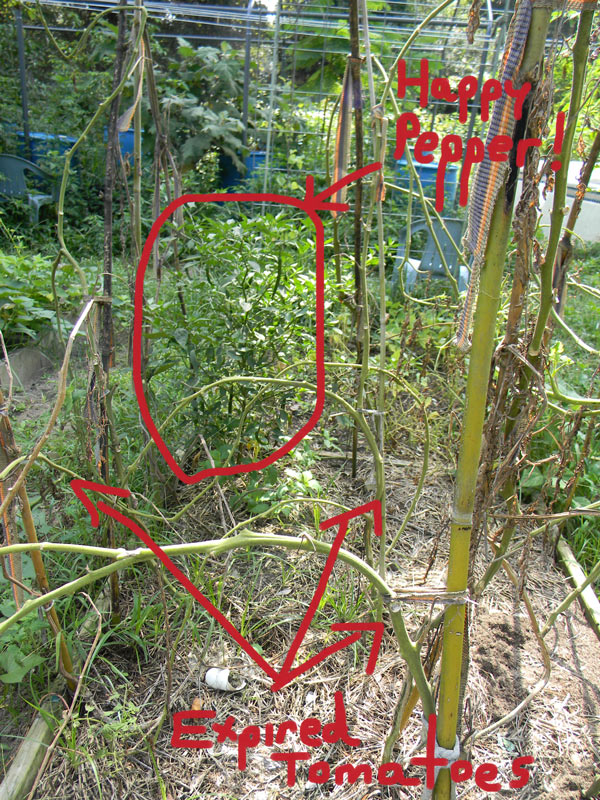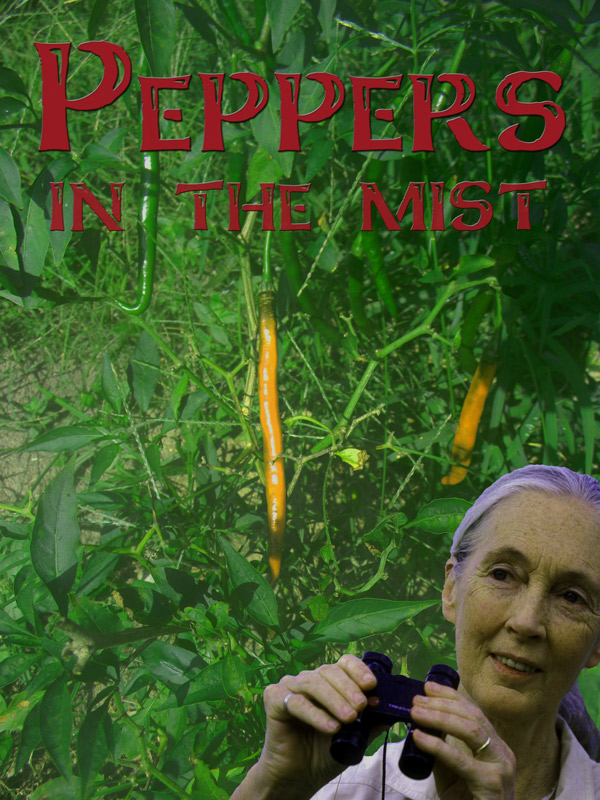When I take my wife out for Thai food, I order my meals “Thai hot.” If I’m not bleeding from my eyes and nose by the end of a meal, it wasn’t spicy enough.
All that said, I’ve never been much of a pepper grower for some reason. Sure, I’ve grown a few thai peppers, some habeneros, a few jalepenos, etc., but I’ve spent more time with fruit trees and root crops.
That’s not to say I don’t grow peppers every year: I do. I just don’t pay much attention to growing them since I always end up getting obsessed with growing something new and exotic. Instead of planning peppers into my garden, I usually realize sometime in late spring that we haven’t planted any, then pop a few in for the heck of it. They’ll keep producing in the heat and through the summer when tomatoes and almost everything else gives up.
Over the last couple of years, I have discovered one pepper that really manages to produce excellently and taste great with no care: the regular old cayenne pepper. Despite my poor planning, I’ve managed to grown them for the last three years without much preparation or thought – and I’m always glad to have their delicious smoky kick in Rachel’s stir-fries.
One of the reasons cayenne peppers rock: they’re perennial. Once you plant these guys, they’ll last multiple years and keep fruiting for you as climate conditions allow. If you get a nasty frost, they’ll die. I piled mulch over four of last year’s plants some time in December, then uncovered them in the spring. Two came back. (I also had a lovely red habenero pepper growing in one of my beds… I dug that one up and put it in a pot in the greenhouse. In the spring, I popped it back in the bed and it’s thriving and producing more habeneros than we can use.)
Growing Cayenne Peppers
To grow peppers, I plant the seeds in flats or in the ground
after the last frost date. They grow quickly and usually will bear
in about three months. Interestingly, I’ve had them self-seed
here and there around my gardens. Occasionally, I’d toss a rotten pepper aside, or throw some in the compost… and a little baby would come up. If I liked its location, I’d leave it. If not, I’ll transplant them
into a bed. My bet is that cayennes are pretty close to being a wild
pepper. They’re tough, and they’re attractive plants to boot.
 |
| Even pepper pests are pretty. |
The only pest problems I’ve had with these guys involve stink bugs. They’ll ruin a few peppers here and there by punching their nasty mouth parts into them and leaving spots that rot – yet even with those losses, we end up with plenty of peppers for the spice cabinet each year. Five plants will provide you with tons – plant more than that and you may need to start your own hot sauce brand.
Something like “Smack Me On My Flaming Butt Of Death And Call Me Satan ‘Cause My Fiery Mouth Is In Hell” brand.
I don’t think that one’s taken yet.
Now let’s take a look at where cayennes fall in the wild world of peppers. For making salsa, jalapenos excel in juiciness and good raw flavor; in brutal heat and smokiness, habeneros are king. For a mild pepper for packing with cheese and rice, poblanos are tops. But the cayenne’s flavor… well, it’s good all around.
I said “good all,” not “Goodall,” dang it!
Where was I? Oh right… uses. The cayenne is a pepper that’s made for drying. It’s got lower moisture right off the plant, so if you string them up, they’ll usually dry pretty well. If you have a lot of humidity (like I do), you can stay safe from mold by putting them in a dehydrator to dry instead.
My favorite use for cayenne peppers is as ground red pepper. I picked
up a Braun coffee grinder at the thrift store for $1.75 and use that for turning dried peppers into homemade ground red pepper.
As a survival plant, this isn’t the best. You can’t live on them, but they sure do add flavor to the things you can eat. There are also proven benefits to consuming hot peppers, such as improved circulation and Looking Cool When Around Your Peers. Hot peppers can also be used to make insect-discouraging sprays for your other plants. They’re also a lot easier to grow than bell peppers, just in case you wondered.
If you haven’t done it before, add a couple of cayenne peppers to your next garden. You’ll be glad you did.
SPUDOMETER RATING:
3 Spuds!
Name: Cayenne pepper
Latin Name: Capsicum annuum (cultivar)
Type: Perennial
Size: 24″ – 36″
Nitrogen Fixer: No
Medicinal: Yes
Cold-hardy: No
Exposure: Full sun
Part Used: Fruit, green and red
Propagation: Seed
Taste: SPICY!
Method of preparation: Raw, stir-fried, in stews, dried and ground
Storability: Good. Dry, pickle or freeze.
Ease of growing: Very easy
Nutrition: Good
Recognizability: High
Availability: High






11 comments
Life is better spicy. I'm training the kiddo to enjoy spicy things, like pepper jack cheese. and as for thai food, thai hot is the best. I just planted some lemongrass this spring. yay!
Tadpoles spontaneously generated in my new pond, and ate every single speck of the wonderful azolla. I didn't see that one coming. I just have a spoonful of duckweed in with my snails, easy come easy go.
Now early in the morning, the new pond sounds like it is populated with two inch tall dinosaurs. My back yard, being largely unmowed and unpruned, is miniature Land of the Lost.
Also, i'm doing my hair like that chick when it turns gray.
Good! I never figured out why women cut their hair short as they near middle age. It's suddenly like, "Hey, I'm totally old and sexless now!" Long hair is definitely more feminine.
"Now early in the morning, the new pond sounds like it is populated with two inch tall dinosaurs. My back yard, being largely unmowed and unpruned, is miniature Land of the Lost."
That's hilarious.
And… I didn't know tadpoles would devour azolla. Dang.
Big habanero fan over here. The stink bugs (my archenemy) were very present until I hit them with diatomaceous earth and they seem to lose interest even after the diatomaceous earth got rained off.
Good deal! I have some DE but didn't bust it out this year… I'll remember that.
The only peppers I have tried growing so far are jalapenos but I’ve had the same experience with them as you’ve had with cayenne; they just don’t quit. On and on, year after year they keep producing. And I don’t like them much so I’ve almost completely neglected them. I like some heat but not a lot. Now I’m growing pablanos; I hope they do as well as the jalapenos.
I’m wondering if bell peppers are perennials too? I have bell pepper plants popping up everywhere, because I planted all the seeds.
Bell peppers may be a short-lived perennial. They just don’t seem to have the “oomph” that the hot ones do.
Let me know how your poblanos do – that’s one I’d like to try.
David, have you tried growing bird peppers. It is a very popular pepper in Grenada. I have a few plants and they produce like crazy. I make green mango salad every season and they add a good kick to the green mango. The two plants that my aunt grew were more than 5 feet tall. I am planning on crossing it with another of my favorite. Have not decided which one yet.
I love to grow peppers, myself, and cayenne always seem to go in the beds. Now I have more reasons to love them. This year I planted cayenne, habanero jalapenos and various bells. The cayenne was the first to give me ripe fruits. Although, I think I planted them too densely and the cardboard beneath is likely keeping them from growing well. Oh well, there’s always hope for next year’s planting. I do like pablano but I forgot to plant them this year. They are great for stuffing with cheeses or whatever your heart desires. They don’t hold up well like a bell, though, unless they are really big with thick walls.
Cayenne will self seed but self seeded cayennes grow in cluster shapes of a cayenne pepper. Amazingly they are very hardy and you can dig them up and put them where you feel they belong, Some I didn’t even shade to get their roots to establish and they took off like rockets after moving them. I recommend potting them up and keeping them shade if you are desperate for success. Then you can transplant after the roots establish. As for me I was just sticking places. I also noticed when the seedlings were in a cluster they survived a frost so if you see a cluster and its not beyond your frost date just leave them (or cover them with a plastic dome like a 2 liter) and dig them up after the threat of the last frost as ended. Some how those clusters retain enough heat to stop a light frost.
Comments are closed.